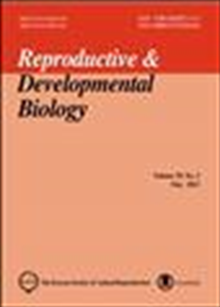간행물
Reproductive & developmental biology

- 발행기관 한국동물번식학회
- 자료유형 학술지
- 간기 계간
- ISSN 1738-2432 (Print)2288-0151 (Online)
- 수록기간 1977 ~ 2018
- 주제분류 농수해양 > 축산학 농수해양 분류의 다른 간행물
- 십진분류KDC 527DDC 636
권호리스트/논문검색
Volume 41 No 2 (2017년 6월) 3건
1.
2017.06
구독 인증기관 무료, 개인회원 유료
Md. Parvez Kabir, Md. Rashedul Islam, Abdulla Al Maruf, Mohammed Shamsuddin, Farida Yeasmin Bari, Nasrin Sultana Juyena, Md Saidur Rahman
Effective estrus detection and artificial insemination (AI) are necessary for profitable management of dairy herd. In current study, 45 crossbred lactating cows have been selected with the complaint of unobserved oestrus for more than sixty days postpartum. All cows had functional corpus luteum as examined by transrectal ultrasonography. Cows were treated with PGF2α analogue and AI was performed with observed oestrus and then single dose of GnRH was administered. Similar synchronization protocol has been repeated after 14 days in cows that did not repose to first treatment. Remaining cows received additional PGF2α after 14 days of second treatment and timed AI was performed following GnRH administration. Among 45 cows, 28.89% showed estrus after first treatment and 78.79% responded to second hormonal intervention. A higher conception rate (88.89% vs 26.66 and 72.72%) was observed in cows after triple administration of PGF2α and timed AI. We noticed a significant differences in body condition score (BCS, 1~5 scale), postpartum period, and daily milk production between cows that either responded of non-responded following first and second hormonal treatment. In addition, there was a significant positive correlation between daily milk production and BCS, age and postpartum days, milk production and estrus/BCS, and milk production/BCS/estrus and conception rate. Depending upon the findings we conclude that hormonal intervention with PGF2α and GnRH enhances postpartum ovarian cyclicity and help decreasing the days open of dairy herd. Therefore, this finding might provide an excellent guideline for target breeding system for profitable dairy herd management.
4,000원
2.
2017.06
구독 인증기관 무료, 개인회원 유료
X-chromosome inactivation is one of the most complex events observed in early embryo developments. The epigenetic changes occurred in female X-chromosome is essential to compensate dosages of X-linked genes between males and females. Because of the relevance of the epigenetic process to the normal embryo developments and stem cell studies, X-chromosome inactivation has been focused intensively for last 10 years. Initiation and regulation of the process is managed by diverse factors. Especially, proteins and non-coding RNAs encoded in X-chromosome inactivation center, and a couple of transcription factors have been reported to regulate the event. In this review, we introduce the reported factors, and how they regulate epigenetic inactivation of X-chromosomes.
4,000원
3.
2017.06
구독 인증기관 무료, 개인회원 유료
Until today, success in germline cells and tissue cryopreservation is limited mainly due to the poor understanding of the complex physiological processes can lead to cell damage during cryopreservation. Germline cells, from both male and female, have unique ability to differentiate into one or more cell lines and thus it becomes a crucial point to store them in subzero temperature with the minimal damage of their functional properties and maximum recovery of unchanged and viable cells when thawed. In the past three decades, a vast research has been performed using various different animal models which in fact have led to development of new methodologies and optimization of older one. However, successful use of animal model has provided the opportunity in research with human germline cells and tissues preservation, but not in all the cases. Therefore, the use of new cryo-protective chemicals and modified protocols have been often found in different groups of researchers based on the types, physical structures, utility and animal species of the specimens to be cryopreserved. This review discusses about the basics of different types of cryopreservation methodologies and commonly used optimized protocols and cryoprotectants for germline cells and tissues preservation.
4,000원

